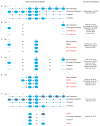Spine Dynamics: Are They All the Same?
- PMID: 28957675
- PMCID: PMC5661952
- DOI: 10.1016/j.neuron.2017.08.008
Spine Dynamics: Are They All the Same?
Abstract
Since Cajal's first drawings of Golgi stained neurons, generations of researchers have been fascinated by the small protrusions, termed spines, studding many neuronal dendrites. Most excitatory synapses in the mammalian CNS are located on dendritic spines, making spines convenient proxies for excitatory synaptic presence. When in vivo imaging revealed that dendritic spines are dynamic structures, their addition and elimination were interpreted as excitatory synapse gain and loss, respectively. Spine imaging has since become a popular assay for excitatory circuit remodeling. In this review, we re-evaluate the validity of using spine dynamics as a straightforward reflection of circuit rewiring. Recent studies tracking both spines and synaptic markers in vivo reveal that 20% of spines lack PSD-95 and are short lived. Although they account for most spine dynamics, their remodeling is unlikely to impact long-term network structure. We discuss distinct roles that spine dynamics can play in circuit remodeling depending on synaptic content.
Keywords: PSD95; dendritic spines; excitatory synapses; in vivo spine imaging; structural remodeling; synapse formation.
Copyright © 2017 Elsevier Inc. All rights reserved.
Figures



References
-
- Ahmed B, Anderson JC, Martin KA, Nelson JC. Map of the synapses onto layer 4 basket cells of the primary visual cortex of the cat. J Comp Neurol. 1997;380:230–242. - PubMed
-
- Al-Hallaq RA, Yasuda RP, Wolfe BB. Enrichment of N-methyl-D-aspartate NR1 splice variants and synaptic proteins in rat postsynaptic densities. J Neurochem. 2001;77:110–119. - PubMed
-
- Arellano JI, Espinosa A, Fairen A, Yuste R, DeFelipe J. Non-synaptic dendritic spines in neocortex. Neuroscience. 2007b;145:464–469. - PubMed
Publication types
MeSH terms
Substances
Grants and funding
LinkOut - more resources
Full Text Sources
Other Literature Sources

